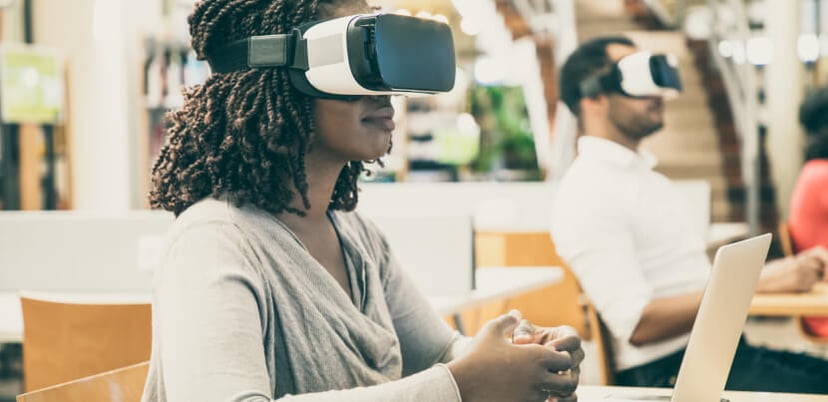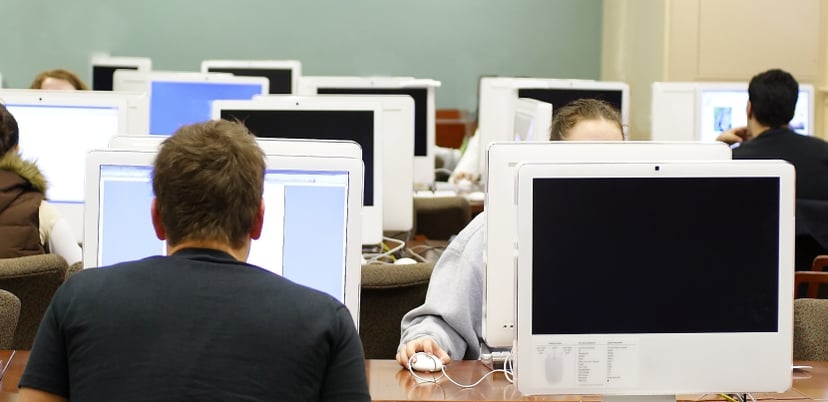What qualifies a public library as "modern" in 2024? Is it cutting-edge architecture and innovative interior design?
That's certainly part of the equation. The fact is, a public library has never really been just a place to check out books and that is especially true in the 21st century.
Our ideas about what constitutes great library design evolves as the needs of patrons grow and change. If the local branch is to be an important hub — a critical part of a community's social infrastructure, as some have argued — library spaces must serve the needs of the widest possible range of users.
Whether it's in a new building or an upgraded older one, the modern library is likely to contain meeting rooms, maker spaces, a teen area, a reading room, an environmental education center or game development labs, with each of these spaces designed to maximize energy efficiency and take advantage of natural light.
A modern space for mindfulness
At its best, the modern library should be a space for mindfulness, where visitors can retreat from the stress of daily life to cultivate attention and focus skills.
For our Future of Libraries report in 2022, we spoke with Elif Tinaztepe, a partner and design principal at Schmidt Hammer Lassen Architects, about how to improve the design of public libraries. She reminded us that great library design should support individual and societal health and well-being. After all, not only is a public library a place to learn, to work and to meet others, but it’s also a place to just be in the present moment — one of the core ideas of most mindfulness practices.
Tinaztepe told us that the important questions to ask when thinking about new public library design include:
How might we design safe and welcoming meeting spaces to support gender equality? Spaces where regardless of ability or disability, everybody has the same level of quality of experience? Can we also support mental fitness in the way we design spaces, with the way we bring daylight in, with the way we make it comfortable and safe for people?
See also:
-
How digital resources at libraries can create a better experience for patrons
-
Digital resources for libraries keep Gen Z and millennial patrons engaged
-
Four library technology trends shaping the future of public libraries
Leveraging technology to enhance services
According to the American Library Association website, "As champions of lifelong learning, libraries are a place to quench curiosity, access technology and explore new ideas, hobbies and careers."
Libraries offer a vital space for continuous personal growth, providing access to an array of books, technology and workshops. Individuals committed to their own development use these resources for research and skill acquisition. They're community hubs where people of all backgrounds can come to learn, explore and grow.
For lifelong learners, libraries are invaluable in fostering a culture of perpetual learning and curiosity. Additionally, libraries often host events and speakers, providing lifelong learners with opportunities to engage with thought leaders. This enriches the lifelong learning experience by connecting them with real-world insights.
Let's take a look at some ways that libraries can meet the needs of any patron looking to become a lifelong learner, whether for personal or professional reasons.
Alongside thoughtful and sustainable architecture and interior design, the evolution of modern libraries has been shaped by digital transformation. In 2024, most branches actively leverage technology to enhance and expand the range of new library services they can offer their members.
Here are a few examples of digital transformation initiatives in public libraries:
Expanded digital resources
Many libraries have expanded their collections to include digital books, audiobooks and other digital resources. Patrons can borrow and download many of these materials remotely, promoting accessibility and convenience.
A growing number of libraries also offer digital news platforms such as PressReader, enabling users to find the newspapers and magazines they desire with access to thousands of publications, including global, national and local titles, covering a wide range of interests.
Online catalogs and reservation systems
Modern libraries often use online catalog systems that streamline the borrowing process by allowing patrons to search for, reserve and renew materials from the comfort of their homes.
E-learning platforms
Libraries have embraced e-learning platforms to offer online courses, tutorials and other educational resources. This facilitates lifelong learning and provides patrons with opportunities to acquire new skills.

Virtual programming and events
Libraries often host virtual and hybrid events, book clubs and workshops using video-conferencing platforms such as Zoom. This not only extends the reach of library programs but also caters to patrons who may face geographical or mobility constraints.
Digital literacy programs
Libraries play a crucial role in promoting digital literacy. They offer workshops and training sessions to help patrons navigate the digital landscape, use online resources effectively and develop essential skills.
This is one way that the library can encourage good "digital citizenship", which MediaSmarts (Canada's Centre for Digital Media Literacy) defines in this succinct way:
Digital citizenship is the ability to navigate our digital environments in a way that's safe and responsible and to actively and respectfully engage in these spaces.
RFID technology
Libraries employ radio-frequency identification (RFID) technology for efficient inventory management, self-checkout systems and security. This enhances the overall library experience by reducing wait times and improving operational efficiency.
Data analytics for decision-making
Libraries use data analytics tools to gather insights into patron behavior, preferences and usage patterns. This information helps library staff make informed decisions about resource allocation and service improvements.

Mobile apps
Libraries often develop mobile applications that allow members to access library services, search catalogs and manage their accounts from smartphones or tablets. This enhances the user experience and supports on-the-go access.
Collaboration with educational institutions
Public libraries are increasingly collaborating with schools and universities to provide seamless access to educational materials. This fosters a culture of learning and research within the community.
Digital archiving and preservation
Some libraries digitize their special collections, historical documents and local archives, making them accessible online for research and exploration by a wider audience.
This helps preserve fragile items, ensuring their long-term availability while enabling access to materials that might have been previously restricted to on-site viewing.
New year, new library resolutions

Digital transformation is an ongoing process, and libraries continue to explore innovative ways to integrate technology into their services to meet the evolving needs of their communities. Because it's never too late to make a New Year's resolution, libraries might even resolve to expand their digital resources and explore new technologies, such as virtual reality and augmented reality, to enhance the user experience.
Here are some other resolutions that modern libraries might consider making to enhance their services, engage the community and stay relevant in the digital age:
Community engagement
Resolution: to strengthen ties with the local community by organizing more events, workshops and book clubs.
How? Use social media platforms to connect with members and keep them informed about the library's various activities.
PressReader’s Self-Pub feature is another way libraries can share information by uploading their own newsletters, announcements and info on upcoming classes and programs.
When libraries use Self-Pub, their patrons will be greeted by the branch's latest content as soon as they open PressReader, ensuring they see important updates and news before they begin browsing the app’s catalog of publications.
Inclusivity and diversity
Resolution: to make a commitment to diversify the library's collection to represent a wide range of voices and perspectives.
How? Implement programs that promote inclusivity, such as cultural events and discussions on social issues. Hosting a human library event is another great way to amplify voices that might not otherwise be heard.
Media literacy programs
Resolution: to develop and promote programs that enhance media literacy skills, catering to all age groups.
How? Many library branches offer media-literacy education programs designed to equip users with the skills to differentiate between genuine information and manipulated content. Through workshops, seminars and one-on-one discussions, librarians are helping to ensure that members of the community develop the skills they need to become informed and engaged citizens.
Flexible spaces
Resolution: to evaluate and reconfigure physical spaces to accommodate flexible use, including collaborative workspaces, quiet study areas and maker spaces.
How? Consider incorporating more comfortable seating and modern amenities to attract a diverse audience. One of the most impactful ways that the modern library can serve its community is to make public spaces available so that people can come together and share ideas, work on projects or just have fun.
Sustainability initiatives
Resolution: to implement eco-friendly practices, such as reducing paper usage, promoting recycling and adopting energy-efficient technologies and sustainable design.
How? In a previous blog post on some of the innovative programs libraries employ to inspire environmental stewardship in their communities, we noted that libraries are a great example of sustainability in action: patrons check out books and other materials, make use of them and then return them to the library for other community members to enjoy. Libraries can also host events, exhibitions or workshops on environmental sustainability and eco-conscious living.
Data security and privacy
Resolution: to prioritize the security and privacy of patron data by regularly updating cybersecurity measures.
How? Protecting patron privacy is a fundamental principle and one of the core values of the library profession, according the American Library Association. In fact, the ALA has enshrined the right to privacy as Article VII of the Library Bill of Rights.
That article states:
All people, regardless of origin, age, background, or views, possess a right to privacy and confidentiality in their library use. Libraries should advocate for, educate about, and protect people’s privacy, safeguarding all library use data, including personally identifiable information.
It's important for libraries to educate staff and patrons about the importance of data security and how the library safeguards personal information.
Remote access and services
Resolution: to enhance online services to allow remote access to library materials and services.
How? Consider expanding virtual reference services and online programming to reach a broader audience.
Offering patrons remote access to a digital news platform like Pressreader, for example, is a great way to provide value, information and entertainment to the community outside of a physical branch.
Continuous staff training
Resolution: to ensure that librarians and other staff members keep their skills up to date in order to better serve library patrons and the wider community.
How? Invest in ongoing professional development for library staff to keep them updated on emerging trends, technologies and best practices in modern library services.
For some specific ideas, see our recent blog post on ways librarians can grow their skills, which include taking free online courses, attending external training programs or workshops, learning Mental Health First Aid and forming reading groups with other library staff members.










